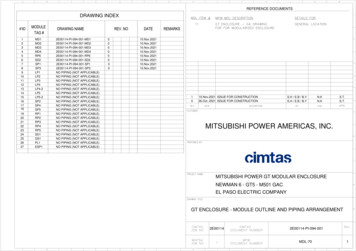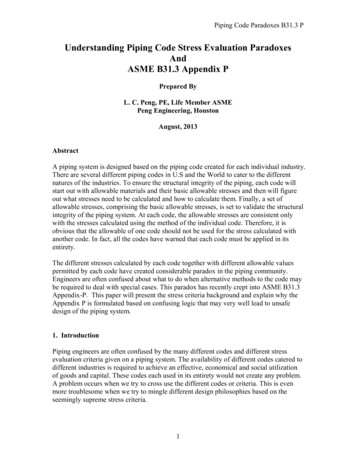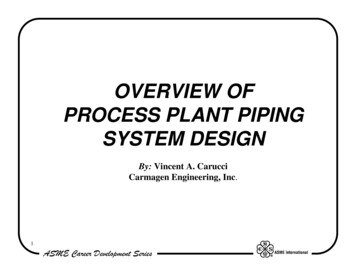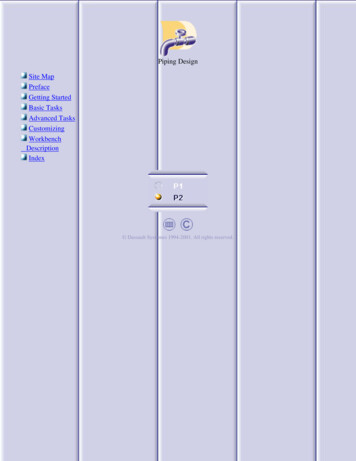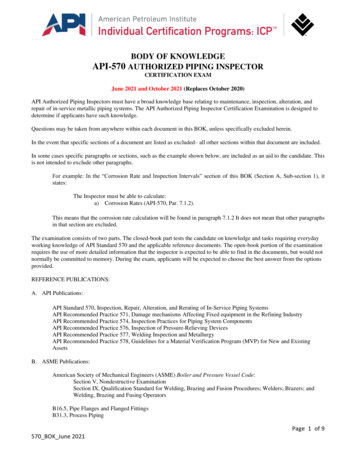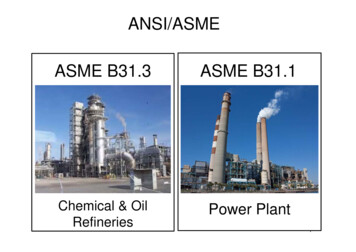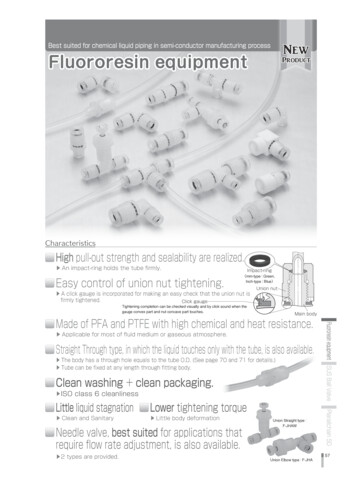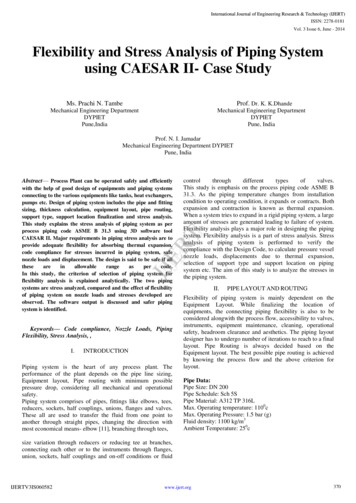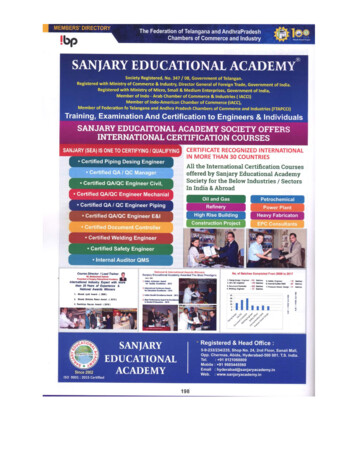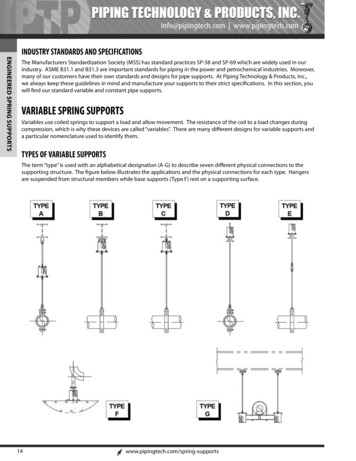
Transcription
ENGINEERED SPRING SUPPORTSINDUSTRY STANDARDS AND SPECIFICATIONSThe Manufacturers Standardization Society (MSS) has standard practices SP-58 and SP-69 which are widely used in ourindustry. ASME B31.1 and B31.3 are important standards for piping in the power and petrochemical industries. Moreover,many of our customers have their own standards and designs for pipe supports. At Piping Technology & Products, Inc.,we always keep these guidelines in mind and manufacture your supports to their strict specifications. In this section, youwill find our standard variable and constant pipe supports.VARIABLE SPRING SUPPORTSVariables use coiled springs to support a load and allow movement. The resistance of the coil to a load changes duringcompression, which is why these devices are called “variables”. There are many different designs for variable supports anda particular nomenclature used to identify them.TYPES OF VARIABLE SUPPORTSThe term “type” is used with an alphabetical designation (A-G) to describe seven different physical connections to thesupporting structure. The figure below illustrates the applications and the physical connections for each type. Hangersare suspended from structural members while base supports (Type F) rest on a supporting surface.14www.pipingtech.com/spring-supports
The spring support is furnished with a threaded bushing in the top plate,providing for a simple rod attachment for the upper connection.TYPES B and CThe spring supports are furnished with one or two lugs welded to the topcap plates of the casing.TYPE DThe spring support permits adjustment from the top, by turning the nutson the hanger rod against a piece of tubing. The tubing is securely weldedto the spring cap. In the type D, the spring is set above the supportingsteel.TYPE EThe spring support permits rod adjustment from either above or belowthe spring. The type E spring is set above the supporting steel or can bewelded directly to the supporting steel from below.TYPE FThe spring support is designed to support piping from below, directly fromthe floor or supporting steel. Adjustment is made by inserting a bar intoholes in the load column and turning the load column as a jack screw. Thebase plate is bolted to the case and has four holes for fastening.ENGINEERED SPRING SUPPORTSTYPE AThe installed height of the base (F-type) spring should be specified asfollows: With upward movement from cold to hot position: The installedheight should be the midpoint between the minimum andmaximum “X” dimension plus the thickness of the load flange. TYPE GWith downward movement from cold to hot position: Theinstalled height should be midpoint between the minimum “X”dimension plus the load flange thickness plus the amount of thevertical movement.The spring support assembly is formed by welding two standard springassemblies to the ends of a pair of channels. Type G assembly canaccommodate unusually heavy loads, and is especially adaptable foravoiding interference in spaces where headroom is limited. The assemblycan be furnished with center-to-center dimensions, as specified by thepurchaser. When ordering Type G, divide the total pipe load in half to selectthe proper spring size. The travel range of the springs remains unchanged.The way a variable spring support responds to an applied load depends on the coil or coils inside the casing. Each coilarrangement has a spring rate expressed in units of pounds/inch (or kilograms/millimeters) of compression. The requiredcoil size is determined by load while the required number of coils (length) is determined by the anticipated range ofmovement. A longer coil or coils placed in series will provide greater travel for similar loads. Manufacturers use theirfigure numbers to designate the coil arrangements which provide greater movement. At Piping Technology & Products,Inc., we use PTP-1, PTP-2, PTP-4, PTP-6, and PTP-8 to designate the five standard coil arrangements we employ to increasethe working range of travel of variable supports. The Load and Travel Tables on Pages 19 and 20 are color-coded toidentify the travel and spring rates for each PTP figure number. These tables can be used to select the PTP figure numberand size required for a particular application.www.pipingtech.com/spring-supports15
ENGINEERED SPRING SUPPORTSLOAD AND TRAVEL TABLEThe twenty-three columns designed 00, 10, 20, ., 220 identify the size and spring rate of coils used in the variables.The larger numbers have higher spring rates and are used to support greater loads. The recommended working rangeof loads for each size is shown between the red lines in the tables. The center of the working range is colored blue.Selecting variables with the loads within the working range provides a reserve above and below to insure the coil canfunction inside the casing.In using the Load and Travel Table to choose the proper variable support, it is best to have the operating (hot) load andan amount and direction of expected movement. Variability is a key criterion in selecting the figure number and size.Variability is the percentage of change in the supporting force between the operating (hot) and installed (cold) positionscalculated as shown:VARIABILITY SPRING RATE X ----OPERATING LOADGood practice, as specified by MSS SP-58, is to choose a support with variability less than or equal to 25%.Always try to choose a variable with the operating (hot) load near the center line (blue) of the working range in the Loadand Travel Table. If you have a situation in which you cannot select a standard variable which has both the operating loadand the installed load within the working range, contact us and we will help you determine alternatives.The quality of the spring coil is very important to performance. Piping Technology buys coils from major suppliers withautomated production facilities and Quality Assurance programs to provide the highest quality at competitive prices. Wekeep an extensive inventory of coils at all times so we can respond to the emergency requirements of our customers.Most of our customers request neoprene coating for their spring coils, which we do in our facility. Neoprene protects thespring coil from many corrosives without affecting the flex life of the coil. In some cases, such as in a furnace installation,temperatures are too high for neoprene. We apply paint or other types of coatings for this situation. Neoprene isrecommended only for operating temperatures up to 255 F.Each variable spring we build is placed in a load cell and calibrated to the design load and movement. The name plates(as shown on Page 17) show the position where the pressure plate meets the coil at the operating (hot) load and theinstalled (cold) load positions. The name plate also shows PTP’s figure number, size, spring rate, and the customer’sdesignated mark or tag number.PTP-1 TYPE F VARIABLE SPRINGS WITH PTFE, 25% GLASS FILLED SLIDE PLATES16B-TYPE VARIABLE SPRING AND CLAMP ASSEMBLIESwww.pipingtech.com/spring-supports
ENGINEERED SPRING SUPPORTSVARIABLE SPRING NAME PLATESPTP-6 F-TYPE VARIABLE SPRING SUPPORTSPHYSICAL DIMENSIONSThe physical dimensions of variables are different depending on the figure numberand size you have selected. The following pages provide drawings and dimensions forevery combination of PTP’s standard variable supports. If you have a requirement forwhich you do not have clearance for the standard spring, please contact us about amodification to satisfy your requirement.During assembly the coils are pre-compressed and travel stops, which are paintedred, are installed and banded in place with steel bands as shown in the figure to theright. Any load, such as in hydro-testing of the pipe, applied to the variable springprior to removing the travel stops will not be applied to the coil. When installation is complete, the travel stops must beremoved so the variable spring can function properly.VARIABLE SPRING ASSEMBLIES WITH BEAM ATTACHMENTSwww.pipingtech.com/spring-supports17
ENGINEERED SPRING SUPPORTSFINISHGalvanizing provides the most cost-effective finish for use in corrosive environments. Because the majority of ourcustomers specify galvanized finish, we maintain a large inventory of galvanized components which enables us toassemble and ship variables very quickly. A longer delivery time may be required when finishes other than galvanizedare specified.SPECIAL FEATURESSpecial features can be provided with the PT&P standard variables whenrequired. For example, lifting lugs, such as those shown in the figure on the right,can be helpful for installing large hangers. Other special features include upperand lower limit stops, guided load columns, jacking bolts, PTFE 25% glass filledslide plates, collars or extended load columns. Special features may increase theprice and the time required for delivery.33,723 LB. LOAD F-TYPE VARIABLE SPRINGS WITHFULLY ADJUSTABLE TRAVEL STOPSPTP-4 TYPE A VARIABLE SPRINGS WITH A DOWNWARD TRAVEL OF 1.375”FEATURES1.Precompression - precompressing the spring coil into the hanger casing saves headroom and erection time.2.Slots in the casing at two locations 180 degrees apart allowing for complete in-service visual inspection of thespring coil and other internal components.3.For each series, there is a reserve travel at the upper and lower limits of the working range of the hanger, andany travel beyond this reserve travel becomes either free up movement or a limit stop for downward travel.4.The allowable stress of the coil spring conforms to MSS SP-58.5.All-steel construction-spring and casing are fabricated of steel and are rugged and compact.6.Anti-corrosive material (stainless steel) is used for the name plate.7.Load Indicators are clearly visible in the slot and are easily readable.8.The piston plate serves as a centering device or guide, maintaining spring concentricity under eccentric loads.9.Finish - hot dipped galvanized, or other, as specified.10. All F-type supports are supplied with a load flange.18www.pipingtech.com/spring-supports
In some cases, such as in a furnace installation, temperatures are too high for neoprene. We apply paint or other types of coatings for this situation. Neoprene is recommended only for operating temperatures up to 255 F. Each variable spring we build is placed in a load cell and calibrated to the design load and movement. The name plates

